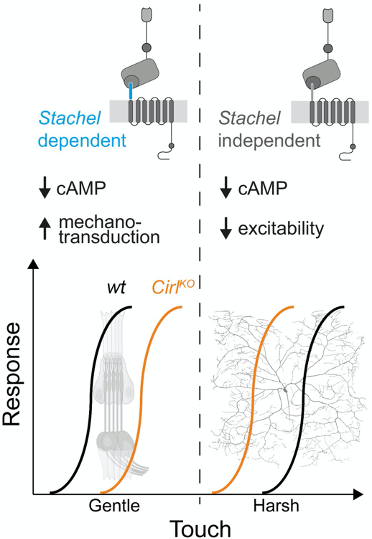
CIRL
We focus on the receptor CIRL – also known as ADGRL or Latrophilin, which according to recent findings may play a role in pain relief. It belongs to the group of so-called G protein-coupled receptors (GPCR) of the adhesion-type. These receptors reside on the membrane of nerve cells, change their shape upon mechanical activation and can thereby activate a guanine nucleotide-binding protein (G protein for short). The G protein in turn modulates the transmission of signals into the cell interior. Activation of antinociceptive GPCRs, such as CIRL, inhibits the transmission of nociceptive impulses and thus the perception of pain.
Research objective
In project 6 of the Clinical Research Unit, we aim to obtain a detailed mechanistic understanding of CIRL function and gain new insights into its role in pain relief and pain resolution. In particular, we will investigate whether activation of CIRL can be used to counteract the nociceptive signals that are transmitted during nerve pain.
Procedure
On the one hand, studies are carried out in the fruit fly Drosophila to elucidate basic molecular mechanisms. On the other hand, the obtained findings are transferred directly to rodents with regressing nerve damage and to patients with complex regional pain syndrome.
Modern techniques
In cooperation with Leipzig University, we are engaging state-of-the-art techniques, including optogenetics and super-resolution microscopy. We are also developing a genetic assay for the resolution of nerve pain in Drosophila. This involves identifying important proteins through transgenic approaches and analysing them in terms of their mechanical stimulus potential. In the fly, nociceptive nerve damage is triggered by the chemotherapeutic drug bortezomib. The screen is available to all KFO projects to test newly discovered candidates for their function in nociception and pain resolution. This is especially true for proteins that are evolutionarily conserved, i.e. are found both in fruit flies as well as rodents and humans.
Significance
So far, the body's own pain relief system has mainly been linked to molecules such as serotonin or morphine. However, if CIRL could also be activated by mechanical stimuli in humans, new, drug-independent options for pain treatment might be possible. For example, physiotherapeutic procedures could be conceivable.
Research Team P6
Leader
Univ.-Prof. Dr. Heike Rittner, MD
Scientific Coordinator of KFO5001
Head of the Centre of Interdisciplinary Pain Medicine (ZiS)
Univ.-Prof. Dr. rer. nat. Robert J. Kittel
Institute of Biology
University of Leipzig
Members of the team
Dr. Mareike Selcho, PhD
Farkhad Abbasov, Assistant Scientist
Mariam Atalla, PhD Student
Aishwarya Aravamudhan, PhD Student
Maria Georgalli, Master Student
Selected Publications
Dannhäuser S, Lux TJ, Hu C, Selcho M, Chen JT, Ehmann N, Sachidanandan D, Stopp S, Pauls D, Pawlak M, Langenhan T, Soba P, Rittner HL, Kittel RJ (2020)
Antinociceptive modulation by the adhesion GPCR CIRL promotes mechanosensory signal discrimination
Elife. 2020 Sep 30;9: e56738. doi: 10.7554/eLife.56738.
Go to publication
Scholz N, Guan C, Nieberler M, Grotemeyer A, Maiellaro I, Gao S, Beck S, Pawlak M, Sauer M, Asan E, Rothemund S, Winkler J, Prömel S, Nagel G, Langenhan T, Kittel RJ (2017)
Mechano-dependent signaling by Latrophilin/CIRL quenches cAMP in proprioceptive neurons
Elife. 2017 Aug 8;6: e28360. doi: 10.7554/eLife.28360.
Go to publication
Scholz N, Gehring J, Guan C, Ljaschenko D, Fischer R, Lakshmanan V, Kittel RJ, Langenhan T (2015)
The adhesion GPCR latrophilin/CIRL shapes mechanosensation
Cell Rep. 2015 May 12; 11(6):866-874. doi: 10.1016/j.celrep.2015.04.008
Go to publication



